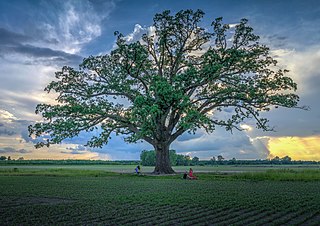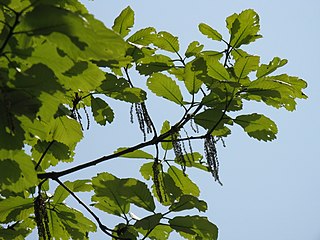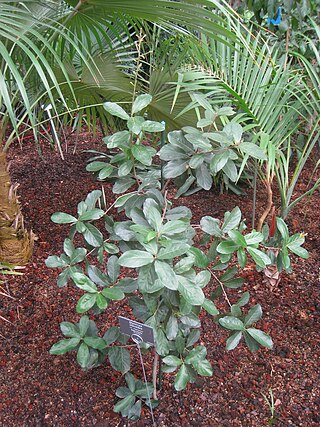
Quercus cerris, the Turkey oak or Austrian oak, is an oak native to south-eastern Europe and Asia Minor. It is the type species of Quercus sect. Cerris, a section of the genus characterised by shoot buds surrounded by soft bristles, bristle-tipped leaf lobes, and acorns that usually mature in 18 months.

Quercus macrocarpa, the bur oak or burr oak, is a species of oak tree native to eastern North America. It is in the white oak section, Quercus sect. Quercus, and is also called mossycup oak, mossycup white oak, blue oak, or scrub oak. The acorns are the largest of any North American oak, and are important food for wildlife.

Quercus gambelii, with the common name Gambel oak, is a deciduous small tree or large shrub that is widespread in the foothills and lower mountains of western North America. It is also regionally called scrub oak, oak brush, and white oak.

Quercus glauca, commonly called ring-cupped oak or Japanese blue oak, is a tree in the beech family (Fagaceae). It is native to eastern and southern Asia, where it is found in Afghanistan, Bhutan, China, northern and eastern India, southern Japan, Kashmir, Korea, Myanmar, Nepal, and Vietnam. It is placed in subgenus Cerris, section Cyclobalanopsis.

Quercus acutissima, the sawtooth oak, is an Asian species of oak native to China, Tibet, Korea, Japan, Indochina and the Himalayas. It is widely planted in many lands and has become naturalized in parts of North America.

Quercus dentata, also called Japanese emperor oak or daimyo oak is a species of oak native to East Asia. The name of the tree is often translated as "sweet oak" in English to distinguish it from Western varieties.

Quercus lyrata, the overcup oak, is an oak in the white oak group. The common name, overcup oak, refers to its acorns that are mostly enclosed within the acorn cup. It is native to lowland wetlands in the eastern and south-central United States, in all the coastal states from New Jersey to Texas, inland as far as Oklahoma, Missouri, and Illinois. There are historical reports of it growing in Iowa, but the species appears to have been extirpated there. It is a slow-growing tree that often takes 25 to 30 years to mature. It has an estimated lifespan of 400 years.

Quercus variabilis, the Chinese cork oak, is a species of oak in the section Quercus sect. Cerris, native to a wide area of eastern Asia in southern, central, and eastern China, Taiwan, Japan, and Korea.

Quercus castaneifolia, the chestnut-leaved oak, is a species of oak in the turkey oak section Quercus sect. Cerris. It is native to the Caucasus and Alborz mountains of Iran, and resembles the closely related Turkey Oak in appearance.

Quercus canariensis, the Algerian oak, Mirbeck's oak or zean oak, is an oak in the section Quercus sect. Mesobalanus, native to southern Portugal, Spain, Tunisia, Algeria and Morocco. Despite the scientific name, it does not occur naturally today in the Canary Islands, though it may have in the past.

Quercus faginea, the Portuguese oak, is a species of oak native to the western Mediterranean region in the Iberian Peninsula. Similar trees in the Atlas Mountains of northwest Africa are usually included in this species, or sometimes treated as a distinct species, Quercus tlemcenensis. It occurs in mountains from sea level to 1,900 metres above sea level, and flourishes in a variety of soils and climates. Out of all the oak forests in the Iberian Peninsula, the southern populations of Portuguese oak were found to have the highest diversity and endemism of spider species.

Quercus ilicifolia, commonly known as bear oak or scrub oak, is a small shrubby oak native to the eastern United States and southeastern Canada. Its range extends in the United States from Maine to North Carolina, with reports of a few populations north of the international frontier in Ontario. The name ilicifolia means "holly-leaved."

Quercus polymorpha, the Mexican white oak, Monterrey oak or netleaf white oak, is a North American species of oak. It is widespread in Mexico, Guatemala, and Honduras, and known from a single population in the United States but widely planted as an ornamental.

Quercus turbinella is a North American species of oak known by the common names shrub oak, turbinella oak, shrub live oak, and gray oak. It is native to Arizona, California, New Mexico, Utah, Colorado, and Nevada in the western United States. It also occurs in northern Mexico.

Quercus arizonica, the Arizona white oak, is a North American tree species in the beech family. It is found in Arizona, New Mexico, western Texas, Sonora, Chihuahua, Coahuila, Sinaloa, and Durango.

Quercus aliena, the galcham oak or oriental white oak, is a species of oak in the family Fagaceae, in the white oak section Quercus.

Quercus ithaburensis, the Mount Tabor oak, is a tree in the beech family Fagaceae. It is found from southeastern Italy to the Palestine region. It is the national tree of Jordan. Two subspecies are accepted, Quercus ithaburensis subsp. ithaburensis and Quercus ithaburensis subsp. macrolepis. Together with Quercus brantii, it forms a clade of distinct, closely related species within the oak section Cerris.

Quercus geminata, commonly called sand live oak, is an evergreen oak tree native to the coastal regions of the subtropical southeastern United States, along the Atlantic Coast from southern Florida northward to southeastern Virginia and along the Gulf Coast westward to southern Mississippi, on seacoast dunes and on white sands in evergreen oak scrubs.

Quercus sagrana, also spelt Quercus sagraeana, the Cuban oak, is a medium-sized evergreen tree native to western Cuba in the Cuban pine forests ecoregion. It is the only oak native to the Caribbean.

Quercus insignis is a Mesoamerican species of oak in the white oak section, within the beech family. It is native to southern Mexico and Central America, from Veracruz to Panamá.



















